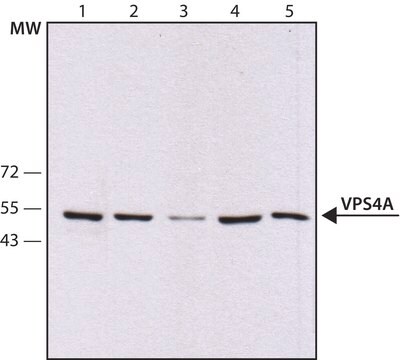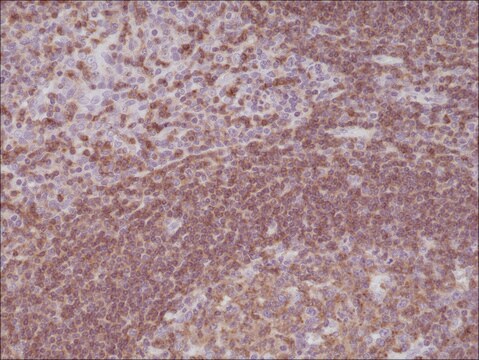ABS1646
Anti-VPS4A (UT289)
serum, from rabbit
Sinonimo/i:
Vacuolar protein sorting-associated protein 4A, Protein SKD2, SKD1-homolog, Vacuolar protein sorting factor 4A, Vacuolar sorting protein 4, VPS4A
About This Item
Prodotti consigliati
Origine biologica
rabbit
Livello qualitativo
Forma dell’anticorpo
serum
Tipo di anticorpo
primary antibodies
Clone
polyclonal
Reattività contro le specie
human, mouse
tecniche
immunocytochemistry: suitable
immunoprecipitation (IP): suitable
western blot: suitable
N° accesso NCBI
N° accesso UniProt
Condizioni di spedizione
ambient
modifica post-traduzionali bersaglio
unmodified
Informazioni sul gene
human ... VPS4A(27183)
mouse ... Vps4A(116733)
Descrizione generale
Specificità
Immunogeno
Applicazioni
Immunoprecipitation Analysis: A representative lot immunoprecipited EGFP-VPS4A fusion together with CHMP5-Myc and Myc-LIP5 exogenously expressed in HEK293T cells. CHMP5-Myc with L4D mutation and Myc-LIP5 with M64A, W147D, or Y278A mutation failed to co-immunoprecipitate with VPS4A (Skalicky, J.J., et al. (2012). J. Biol. Chem. 287(52):43910-43926).
Western Blotting Analysis: A representative lot detected both endogenous VPS4A and exogenously expressed EGFP-VPS4A fusion in HEK293T cell lysates as well as in Anti-Myc immunoprecipites from CHMP5-Myc or Myc-LIP5 expressing cells (Skalicky, J.J., et al. (2012). J. Biol. Chem. 287(52):43910-43926).
Western Blotting Analysis: A representative lot detected the VPS4A target band in lysate from untransfected, but not VPS4A shRNA-transfected, HeLa cells (Morita, E., et al. (2010). Proc. Natl. Acad. Sci. U.S.A. 107(29):12889-12894).
Signaling
Qualità
Western Blotting Analysis: A 1:1,000 dilution of this antiserum detected VPS4A in 10 µg of MCF-7 cell lysate.
Descrizione del bersaglio
Stato fisico
Stoccaggio e stabilità
Handling Recommendations: Upon receipt and prior to removing the cap, centrifuge the vial and gently mix the solution. Aliquot into microcentrifuge tubes and store at -20°C. Avoid repeated freeze/thaw cycles, which may damage IgG and affect product performance.
Altre note
Esclusione di responsabilità
Non trovi il prodotto giusto?
Prova il nostro Motore di ricerca dei prodotti.
Codice della classe di stoccaggio
12 - Non Combustible Liquids
Classe di pericolosità dell'acqua (WGK)
WGK 1
Certificati d'analisi (COA)
Cerca il Certificati d'analisi (COA) digitando il numero di lotto/batch corrispondente. I numeri di lotto o di batch sono stampati sull'etichetta dei prodotti dopo la parola ‘Lotto’ o ‘Batch’.
Possiedi già questo prodotto?
I documenti relativi ai prodotti acquistati recentemente sono disponibili nell’Archivio dei documenti.
Il team dei nostri ricercatori vanta grande esperienza in tutte le aree della ricerca quali Life Science, scienza dei materiali, sintesi chimica, cromatografia, discipline analitiche, ecc..
Contatta l'Assistenza Tecnica.






